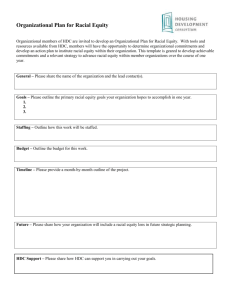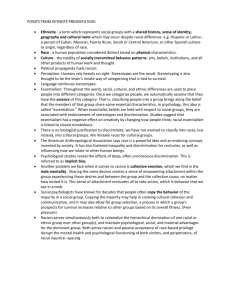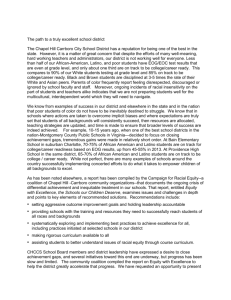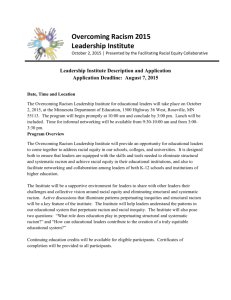Glossary of terms - Toronto Arts Council
advertisement
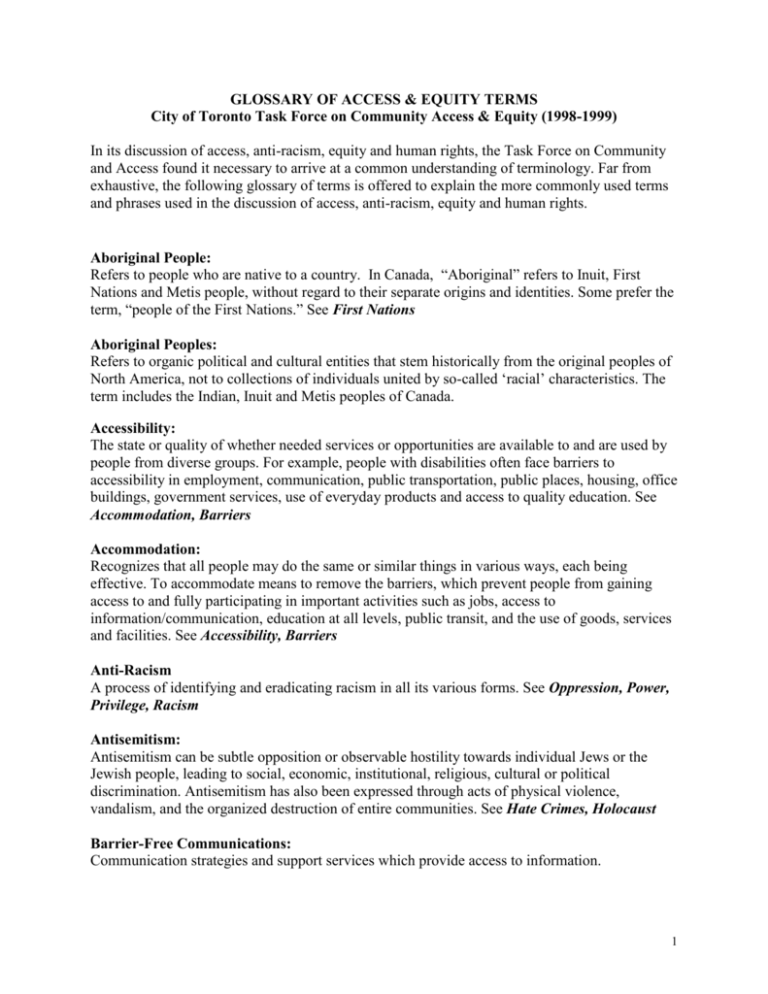
GLOSSARY OF ACCESS & EQUITY TERMS City of Toronto Task Force on Community Access & Equity (1998-1999) In its discussion of access, anti-racism, equity and human rights, the Task Force on Community and Access found it necessary to arrive at a common understanding of terminology. Far from exhaustive, the following glossary of terms is offered to explain the more commonly used terms and phrases used in the discussion of access, anti-racism, equity and human rights. Aboriginal People: Refers to people who are native to a country. In Canada, “Aboriginal” refers to Inuit, First Nations and Metis people, without regard to their separate origins and identities. Some prefer the term, “people of the First Nations.” See First Nations Aboriginal Peoples: Refers to organic political and cultural entities that stem historically from the original peoples of North America, not to collections of individuals united by so-called ‘racial’ characteristics. The term includes the Indian, Inuit and Metis peoples of Canada. Accessibility: The state or quality of whether needed services or opportunities are available to and are used by people from diverse groups. For example, people with disabilities often face barriers to accessibility in employment, communication, public transportation, public places, housing, office buildings, government services, use of everyday products and access to quality education. See Accommodation, Barriers Accommodation: Recognizes that all people may do the same or similar things in various ways, each being effective. To accommodate means to remove the barriers, which prevent people from gaining access to and fully participating in important activities such as jobs, access to information/communication, education at all levels, public transit, and the use of goods, services and facilities. See Accessibility, Barriers Anti-Racism A process of identifying and eradicating racism in all its various forms. See Oppression, Power, Privilege, Racism Antisemitism: Antisemitism can be subtle opposition or observable hostility towards individual Jews or the Jewish people, leading to social, economic, institutional, religious, cultural or political discrimination. Antisemitism has also been expressed through acts of physical violence, vandalism, and the organized destruction of entire communities. See Hate Crimes, Holocaust Barrier-Free Communications: Communication strategies and support services which provide access to information. 1 Also referred to as Alternative or Accessible Formats. Alternative /Accessible Formats are forms of communication other than conventional print or video formats. Alternative formats include computer diskette, large print, Braille, audiocassette, video windowing and captioning, descriptive narration. Communications support services include interpreting services, computerized notetaking, real-time captioning, and assistive listening systems. Barrier-Free Communication should also be provided in clear language and design. See Accessibility, Accommodation, Clear Language and Design, Literacy, Numeracy Barriers: A barrier is an obstacle, which must be overcome or removed for equity/access to be possible. Barriers to access and equity can be physical, attitudinal, sociological, financial, geographic, and/or systemic. See Accessibility, Accommodation, Racism, Sexism Bisexual: Bisexual people are men or women who relate emotionally and sexually to either men or women. See, Gay, Heterosexual, Homophobia, Homosexuality, Lesbian, Sexual Orientation, Transgendered, Transsexual Blind: Describes people with little or no vision. See Disability Civic Participation: Civic participation is the involvement and participation of residents in the decision making process; as well as in the planning, development and delivery of municipal services. Civic participation programs seek to develop residents and provide them with opportunities to participate in shaping the future of their communities. For example, residents may participate in municipal elections, serve on advisory committees or working groups, make presentations or deputations to committees of City Council; or seek appointments to agencies, boards, commissions and special purpose bodies. Class: A term, which refers to a category of division, based on economic status. Members of a class are theoretically assumed to possess similar cultural, political and economic characteristics and principles. Clear Language and Design: Clear language and design refers to principles and guidelines, which promote reading effectiveness of written materials. Clear language and design guidelines assist in ensuring the document /written material is able to get the “message” across to the intended audience. See Barrier-Free Communication, Literacy, Numeracy Community: “Community” is a term, which can be used, in a broad or narrow sense. Community can refer to a group of people living together in one locality and who are subject to the same laws, having common interests and characteristics, e.g. A religious community, a rural community. 2 Community can also be used to define a group by their range of needs or experience, common ownership or participation, for example: period of settlement, range of language needs, accommodation needs, experience of governments, experience of racism. In order to foster community participation, it is critical to be sensitive to the range of diversity that exists in order to plan appropriate strategies, which respond to specific community realities. Consecutive Interpretation: The process of interpretation which follows successively without interruption. See Barrier-Free Communications, Interpreting, Interpreting Services, Simultaneous Interpretation, Translation Convention Refugee: A refugee who fits the United Nations definition: “Any person who, by reason of a well founded fear of persecution for reasons of race, religion, nationality, membership in a particular group or political opinion: a) is outside the country of their nationality and is unable, or by reason of such fear, is unwilling to avail him/herself of the protection of that country; or, b) not having a country of nationality is outside the country of habitual residence and is by reason of such fear, unable to or unwilling to return to that country”. See Immigrant, Refugee Culture: Culture refers to the way groups of people have learned to live by sharing certain historical experiences, including ideas, beliefs, values, knowledge, historical, geographical, linguistic, racial, religious, ethnic or social traditions. Culture is a complex and dynamic organization of meaning, knowledge, artifacts and symbols that guide human behaviour, account for shared patterns of thought and action; and, contribute to human, social, and physical survival. Culture is transmitted, reinforced, passed on and changes. Deaf: Describes people who cannot hear and whose primary communication mode is visual, such as sign language. See Disability Deaf-blind: Describe people who have varying combinations of visual and auditory impairments. See Disability Deafened: Describes people who become deaf later in life. People who are deafened are less likely to use sign language as a primary mode of communication. See Disability Designated Groups: Employment Equity designated groups refers to social groups whose members had historically been denied equal access to employment, education, social services, housing because of 3 membership in the group. The designated groups in Canada are visible minorities, women, Aboriginal peoples, and people with disabilities. See Employment Equity, Equity-Seeking Groups Disability: A disability is a natural or acquired characteristic(s) of an individual which may prevent full participation in educational, social, economic, political, religious, institutional or formal activities of a group, or that may require accommodation to enable full participation. Disabilities could be physical, cognitive, and emotional or, can affect a person’s ability to learn. Disabilities may be visible or hidden, severe or mild, singular or multiple, chronic or intermittent. See Access, Accommodation, Barriers, and People with disabilities Discrimination: Discrimination is the denial of equal treatment, civil liberties and opportunity – the unequal treatment of people or groups resulting in subordination and deprivation of political, social and economic rights with respect to education, accommodation, health care, employment, and access to goods, services and facilities. Discrimination may occur on the basis of race, nationality, ethnicity, gender, sexual orientation, age, religious or political affiliation, marital or family status, or disability. Discrimination is often invisible to those who are not its targets. There are three kinds of discrimination: 1) Overt Discrimination: Either the granting or denying of certain rights to certain groups or individuals. 2) Unequal Treatment: The differential treatment of one group in comparison with another because of certain characteristics (ie. paying lower wages to women in comparison to me for work of equal value). 3) Systemic Discrimination: The policies and practices lodged firmly in established institutions, which result in the exclusion or promotion of designated groups. It differs from overt discrimination in that no individual intent is necessary. Diversity: Diversity is a term, which refers to the broad variety of differences and similarities among people. Often used within the context of culture, education, the workplace and business, diversity refers to differences and similarities in a number of dimensions which include, but are not limited to: race, age, place of origin, religion, ancestry, colour, citizenship, sex, sexual orientation, ethnic origin, disability, marital, parental or family status, educational background, literacy, geographical location, income, cultural tradition and work experience. See Multiculturalism Economic: Refers to anything having to do with money or wealth. Economic power is the use of money or wealth to get what a person or people want. See Low-Income Group, Marginalization, Poverty, Power, Refugee 4 Employment Equity Programs : A set of practices or program designed to identify and eliminate discriminatory policies and practices that create unfair or unequal employment opportunities, removes barriers and provides equitable opportunities in employment for designated groups. Employment equity means more than treating persons in the same way but also requires special measures and accommodation of differences. The quality of the results is as important as equality of treatment. See Designated Groups, Employment Systems Review Employment Systems Review: An employment systems review is an objective review of an organization’s employment systems. The review helps to ensure that employment practices, procedures and programs are accessible and equitable to all members of the workforce and to all potential employees. See Designated Groups, Employment Equity Equal Opportunity: Equal Opportunity refers to policies, practices and guidelines that eliminate discriminatory practices and ensure equal access to employment, services, education and housing. See Barriers, Designated Groups, Employment Equity, Employment Systems Review Equal Pay for Equal Work: “Equal Pay for Equal Work” is not the same as Pay Equity. “Equal Pay for Equal Work” is a requirement regulated under the Employment Standards Act of the Ontario’s Ministry of Labour. “Equal Pay for Equal Work” means that if a woman and a man are doing substantially the same work, for the same organization or company, they must receive the same wage unless the difference in pay is due to seniority or merit. See Pay Equity Equal Treatment: Equal treatment is treatment that brings about an equality of results that may in some instances, require different treatment. For example, providing an accessible ramp at the entrance of a building gives everyone equal treatment in entering the building. Equality: See Hierarchy/equality Equity: The rights of the individual to an equitable share of the goods and services in society. However, equality of treatment will not guarantee equal results. Creating equal results sometimes requires treating people differently from each other. Focussing on the results instead of the treatment is the concept of equity. See Equality Equity-Seeking Groups: 5 This is a term, which covers groups who face barriers to equal access which are similar to those faced by the “employment equity designated groups”. Equity-seeking groups include groups whose members are treated differently because of their faith, immigrant status, sexual orientation, economic status, and level of education and/or literacy. See Designated Groups Ethnic Group: A community that is maintained by a shared heritage, culture, language or religion; a human group bound together by ties of cultural homogeneity, with a prevailing loyalty and adherence to certain basic institutions such as a family pattern, religion and language. Everyone belongs to an ethnic group. The term is often confused with ‘racial minority’. See Ethnic Group, Ethnicity, Ethnocentrism, Ethnoculture, Racial Minority Ethnicity: The many and varied beliefs, behaviours and traditions held in common by a group of people of a particular linguistic, historical, national, geographical, religious, racial and/or cultural origin. Ethnic diversity refers to the variety of similarities and differences of such groups, and to the presence of a number of groups within one society or nation. In Canada, ethnicity refers to the original homeland or homeland of ancestors prior to immigration to Canada. See Ethnic Group, Ethnicity, Ethnocentrism, Ethnoculture, Racial Minority Ethnocentrism: To see other societies and cultures from the point of view of your own society and culture rather in their own terms. Tendencies to view others using ones own group and customs as the standard for judgement and the tendency to see one’s group, country, and customs as the best. See Ethnic Group, Ethnicity, Ethnoculture, Racial Minority Ethnoculture/ethnocultural: Every person belongs to an ethnic group and each identifies with some cultural heritage shared by people of certain national, religious and/or language backgrounds. The term ethnocultural refers an ethnic identity supported by cultural practice, tradition and institutions. A group of people who believe they are ethnically and/or culturally distinct from other groups. For example, there are a wide variety of ethnocultural groups among people of African, Asian, European and indigenous Northern, Central and South American backgrounds in Canada. See Aboriginal, Culture, Ethnic Group, Ethnicity, Ethnocentrism, Racial Minority Ethno-Racial: Pertaining to ethnic and racial minorities. Ethno-Specific: Pertaining to a single ethnic group. First Nations: The First Nations of Canada are those peoples that were here before European settlement. First Nations include North American Indian, Status or Non-Status, Inuit or Metis. The term “First 6 Nations” people has evolved from “Indian” to “Native” to “Aboriginal” or First Nations. See Aboriginal People, Aboriginal Peoples Gay: A term which usually refers to men who relate emotionally and sexually, primarily to the same gender. This term is also used by some women who relate emotionally and sexually, primarily to the same gender. See Bisexual, Homosexuality, Homophobia, Lesbian, Sexual Orientation, Transgendered, Transsexuals Gender/Sex: Gender refers to roles and meanings assigned to men and women based on their presumed biological sex. Gender makes a person male or female through a collection of socially defined traits, for example, appearance, attitudes, roles, preferences, work and so on. Sex refers to the physical/biological characteristics of a person which makes him or her male or female. See Sexual Orientation Harassment: Harassment is a form of discrimination and many forms of harassment are illegal. The aim of harassment is to make people feel unwelcome on the basis of their race, ancestry, place of origin, colour, ethnic origin, citizenship, religion, sex, sexual orientation, age record of offences, marital status, family status or disability. Harassment may be either subtle or blunt and may take the form of: name-calling; inappropriate jokes or slurs; graffiti; displaying pin-ups, pornography or other offensive materials; unwelcome touching; actions that invade privacy; uttering insults or threats; discourteous treatment; physical or sexual assault. See Discrimination, Hate Crime, Hate Activity, Ontario Human Rights Code Hard of Hearing: Describes people who have any degree of hearing loss ranging from mild to profound. People who are hard of hearing can understand some speech sounds, with or without a hearing aid, and communicate primarily by speech. They often use hearing aids, lip-reading and other assistive technologies. See Disability Hate Crime/Hate Activity: A hate crime is a criminal offence committed against a person or property, that is motivated by the suspect/offender’s hate or bias against a racial, religious, national, ethnic, sexual orientation, gender or disability group. Hate Literature: Ideologies and beliefs transmitted in written or electronic form in order to create, perpetuate or promote antagonistic and belligerent attitudes and actions directed against a specific group of people. See Hate Crime/Hate Activity Heterosexism: 7 Heterosexism refers to the act, belief or system of the inherent superiority of heterosexuals and the assumption that everyone is heterosexual. See Heterosexual, Homophobia Heterosexual: Heterosexuals are men or women who relate, emotionally and sexually to people of the opposite sex. See Heterosexism Hierarchy/equality: A hierarchy is a social arrangement where some have more status and power than others. Equality is a social structure based on everyone having equal value and equal access to power. Holocaust: Widespread destruction and loss of life, especially by fire. The term specifically refers to the systematic murder of over six million Jews in concentration camps and death camps during the Second World War. See Antisemitism Home Language: Refers to the language spoken most often at home by an individual. See Mother Tongue/First Language Homelessness: Homelessness is a social condition referring to the growing number of homeless people seen on city streets. Homeless people includes those who are “visible” on the streets or staying in hotels; “hidden” homeless, who live in illegal or temporary accommodation; and those at risk of soon becoming homeless. Homelessness can result from poverty, loss of wage/income, lack of affordable housing, mental illness or addictions or social factors such as domestic violence, physical and sexual abuse. See Low Income, Poverty Homophobia: Homophobia is a reaction of fear and hatred of homosexuality, acted out through discrimination, harassment and violence. See Bisexual, Gay, Homosexuality, Lesbian, Transgendered, Transsexuals Homosexuality: A term used to describe persons who relate emotionally and sexually to people of the same gender. See Lesbian, Gay, Bisexual, Heterosexual Immigrant: One who moves from his/her place of origin to another country. See Convention Refugee, Refugee Immigrant Settlement Programs; Immigrant Settlement Programs refers to the range of programs and services designed to assist newcomers with their settlement needs, including needs related to language, housing and counseling services, and employment. In Canada, the settlement programs are the responsibility of the national government while the services are delivered locally. 8 Immigration: The act of taking up permanent residence in a country that is not one’s birthplace. Interpreting: Interpreting is a term, which means to translate orally. See Consecutive Interpretation, Interpreting Services, Simultaneous Interpretation, Translation Interpreting Services: Interpreting services refers to a range of communication support services, which are intended to remove communication/language barriers. Services include language translation and interpreting; and, the provision of sign language interpreters. Lesbian: Lesbians are women who relate, emotionally and sexually, primarily to the same gender. See Bisexual, Gay, Heterosexism, Homophobia, Homosexuality, Mysogyny Literacy: “Literacy” is a person’s ability to understand and use printed information in daily activities at home, work and in the community in order to reach personal goals and develop individual potential. As literacy skills are not and cannot remain static, they must be continually used and updated as information demands increase. Literacy may also refer to sign language and other forms of communication. See Clear Language and Design, Numeracy Low-Income Group: A term that refers to people who have been identified as eligible for Workers’ Compensation Programs, or income support programs through a financial needs assessment. Low-income earners may be unemployed, low-wage workers, or students attending school. See Economic, Homelessness, Poverty, Power Majority Group: The group within a society that is largest in number or successfully determines or controls the economic, social, political and educational base. The term suggests social position and power. See Economic, Low-Income Group, Marginalization, Minority Group, Poverty, Power Marginalization: Marginalization refers to the experience of certain groups, which do not have full and equal access to and cannot participate in the social, economic, cultural and political institutions of society. See Economic, Low-Income Group, Majority Group, Minority Group, Poverty, Power Minority Group: Refers to a group of people within a given society that is either small in number, or, which has little or no access to social, economic, political, cultural or religious power due to ethnicity, race, income, sex, disability, faith, or other factors. The term implies inferior social standing. See Economic, Low-Income Group, Majority Group, Marginalization, Poverty, Power 9 Misogyny: Misogyny is hatred, fear, and mistreatment of women either by individuals or institutions. Mother Tongue/First Language: Refers to the first language learned at home in childhood and still understood by the individual. See Home Language Multiculturalism: Multiculturalism is a concept, which refers to the composition of Canada both historically and currently, referring to the cultural and racial diversity of Canadian society. Multiculturalism is also an ideology, which holds that racial, cultural, religious and linguistic diversity is integral, beneficial, and a necessary part of Canadian society and identity. Native: See Aboriginal People, First Nations Numeracy: Reading and numeracy skills are closely related. Basic numeracy skills include the ability to recognize numbers in isolation or short text; and, the ability to perform simple math skills such as addition and subtraction. See Clear Language and Design, Literacy Official Languages: English and French are the two official languages in Canada. “Anglophone” refers to Englishspeaking persons, “Francophone” refers to French-speaking persons. Ontario Human Rights Code: A law in Ontario which provides protection from discrimination at work, in housing, in the receipt and delivery of services, contracts; and respecting membership in unions, trade or vocational associations. The Code also provides protection from people who are bothering, threatening or insulting you by saying or doing things that are not welcome. This is called harassment. Under the Ontario Human Rights Code, discrimination means someone is treating you unfairly because of race, colour, ancestry, place of origin (where you were born), ethnic background, citizenship, creed (religion), sex, disability, sexual orientation, age, marital or family status, or receipt of public assistance. See Discrimination Oppression/oppressor/oppresses: Oppression occurs when one group of people uses different forms of power to keep another group down in order to exploit them. The oppressor uses the power; the oppressed are exploited. See Economic, Literacy, Low-Income Group, Majority Group, Minority Group, Marginalization, Power, Privilege Pay Equity: In Ontario, the Pay Equity Act is intended to narrow the wage gap that exists between women’s and men’s wages. Pay equity is equal pay for work of equal or comparable value. The process requires a comprehensive gender-neutral job evaluation system, which compares different types of work in the areas of skill, effort, responsibilities and work conditions. Pay equity requires that 10 compensation(wages and benefits) be at least the same for jobs performed mainly by women that are equal or comparable to jobs performed mainly by men, even if the jobs are quite different. Pay Equity is broader than the concept of equal pay for equal work. See Equal Pay for Equal Work People of Colour: A term which applies to members of racial minorities, other than Aboriginal people who are nonCaucasian in race or non-white in colour, and who so identify themselves or agree to be so identified. In the Canadian context, the term refers to a group of people who because of their physical characteristics are subjected to differential and unequal treatment. People with disabilities: People with disabilities refers to members of a group who identify themselves as having or agree to be identified as having different disabilities and therefore have different and varying needs; and who may experience different types of discrimination. There are a wide variety of disabilities. They include multiple sclerosis, cystic fibrosis, mobility disability, hearing or visual disability, epilepsy, and developmental or psychiatric disabilities. Poverty: In Canada, living in poverty refers to the level at which a person’s income source measures below Statistics Canada’s low-income cut-off rates. Income sources could include earnings, from one of the income support programs, or through support from family and friends. See Economic, Homelessness, Low-Income Group, Oppression, Marginalization, Minority Group, Power Power: Control of and access to economic, political, educational, and social structures. See Oppression/oppressor/oppressed, Privilege Prejudice: A mental state or attitude of prejudging (usually unfavourably) a person or group, characteristics falsely attributed to the group as a whole. Privilege: Unearned power which gives certain groups economic, social and political advantages. The unequal distribution of resources and status. The ability to access resources, receive, acquire or assume benefits, on the basis of this status. Status can be based on things we as individuals have little or no control over, including sex, race, culture, ability, wealth and age. See Economic, Majority group, Oppression, Power Race: A category used to classify people by common ancestry and relies on the differences in physical characteristics as colour of skin, hair texture, stature and facial characteristics. See People of Colour, Race Relations, Racism Race Relations: 11 Interactions between diverse racial groups within one society. The term race relations can also refer to the development of programs, policies and guidelines which promotes positive transracial and cross-cultural relations by eliminating racial intolerance and removing racial disadvantage. See Race, Racial Minority, Racism Racial Minority: See Oppression, People of Colour, Racism, Visible Minority Racism: Racism is a system in which one individual or group of people exercise power over another individual or group on the basis of skin colour. It is based on the erroneous belief that one racial or ethnic group is better; more capable; somehow superior to other groups as determined by hereditary factors. Racism is a barrier, which can be built into and supported by our social/political/economic systems and institutions. For example, unnecessary height/weight requirements may screen racial minority groups and the demand for Canadian experience may screen immigrants from employment opportunities. See Barriers, Oppression, Power, Privilege, Sexism Refugee: A refugee is a person who flees his/her country of origin for fear of persecution, or death; or for economic reasons. See Convention Refugee, Economic, Refugee Claimant Refugee Claimant: In Canada, a Refugee Claimant is a person who arrives in the country and requests legal refugee status. See Convention Refugee, Economic, Immigrant, Refugee Self Determination: The right of a people to determine their political future and freely pursue their economic, cultural and social development, independent of the status quo. In Canada, “self determination” refers to Aboriginal people and Aboriginal self-governance. See Aboriginal People Aboriginal Peoples Sexism: Sexism is a set of beliefs and /or actions by an individual, organization, institutional structures or programs which oppresses women; sexism is a discriminatory act backed by power which subordinates women because of their gender. Sexism is a barrier, which can be built into and supported by our systems and institutions. For example, unnecessary height/weight requirements may act as a barrier to women in employment. See Barriers, Racism Sexual Orientation: Sexual orientation refers to a person’s emotional, physical, and/or sexual attraction to people of their own sex or the opposite sex. See Barriers, Bisexual, Gay, Harassment, Homosexuality, Lesbian, Sexism, Transgendered , Transsexual Simultaneous Interpretation: The act of interpretation happening or done at the same time. See Barrier-Free Communications, Consecutive Interpretation, Interpreting, Interpreting Services, Translation 12 Social Justice: A concept based on the belief that each individual and group within a given society has a right to equal opportunity, civil liberties, and full participation in the social, educational, economic, institutional, and moral freedoms and responsibilities of that society. Stereotype: A generalized conception of a group of people which results in the unconscious or conscious categorization of each member of that group, without regard for individual differences. Simply put, to stereotype is to have an oversimplified image of a group which ignores the individual differences and diversity that exist within any group of people. Tolerance: Acceptance and open-mindedness to different practices, attitudes and cultures. To tolerate different practices, attitudes and cultures does not necessarily mean agreement with the differences. See Diversity, Multiculturalism Transgendered: An umbrella term which describes all individuals who have chosen to cross the lines of the sex and/or gender they were assigned at birth. See Sexual Orientation Translation: The art or process of expressing in another language systematically retaining original sense. See Barrier-Free Communications, Consecutive Interpretation, Interpreting, Interpreting Services, Simultaneous Interpretation, Translation Transsexual: An individual who is engaged in the process or has completed the process of undergoing a sex change to physically alter their sex and gender. See Sexual Orientation TTY or TDD: Tele-typewriter or Telecommunications Devices for the Deaf are telephone devices used with the telephone for communication between deaf, hard of hearing, speech-impaired and/or hearing persons. Also known as text telephone (TT). See Barrier-Free Communications, Accommodation Visible Minority: A term that has been used to refer to people who are visibly different from members of the majority culture. The terms, racial minority and people of colour are also used. The term is also used to classify individuals for the purpose of employment equity programs. In this context, visible minority groups include Black, Indo-Pakistani, Chinese, Korean, Japanese, South East Asian, Filipino, other Pacific Islanders, West Asian, Arab, Latin American, Aboriginal and multiple origins. See People of Colour, Racial Minority White People: 13 A social rather than scientific construct. It is recognized that there are many people who are white but who face discrimination because of their class, sexual orientation, gender, ethnicity, religion, age, language, and geographical origin. Grouping all these people as white is not to deny the forms of discrimination that people of certain ancestry face (such as Italian, Portuguese, Jewish, Armenian) because of these factors. The term refers to people belonging to the dominant group who enjoy skin privilege in North America, Europe, Australia and New Zealand. Glossary was compiled with assistance from various sources including the following: The ASTD Trainer’s Sourcebook on Diversity, Tina Rasmussen. Becoming an Ally – Breaking the Cycle of Oppression. Anne Bishop, Fernwood Publishing, Halifax, 1994. The Colour of Democracy: Racism in Canadian Society. Frances Henry et al, Harcourt Brace, 1996. The Colour of Democracy: Racism in Canadian Society, Second Edition. Frances Henry et al, Harcourt Brace, 2000. Contract Compliance Program. Equal Opportunity Division, City of Toronto, March 1991. Hate Communities Can Respond: A Community Handbook. Cassandra Fernandes & Donna Costanzo, Community Advisory Committee on Anti-Hate and Anti-Racism, 1996 Awareness to Action. Besty Kappel & Zubeida Ramji, Municipality of Metropolitan Toronto, Chief Administrator’s Office, 1996. Glossary – A. Multicultural & Race Relations Action Planning Project. Feminist Research Ethics: A Process. Martha Muzychka, et al., The Canadian Research Institute for the Advancement of Women, October 1996. Challenging Barriers in Delivery and Customer Service. The Multicultural Relations Division, Municipality of Metropolitan Toronto, 1996. Living With Disability in Canada: An Economic Portrait. Gail Fawcett. Human Resources Development Canada, 1996. The Out!spoken Style Guide , 3rd edition. 14 Royal Commission on Aboriginal Peoples. Vol. 4 “Perspectives and Realities” Race Relations: Myth and Facts. Toronto’s Mayor’s Committee on Community and Race Relations, City of Toronto. Taking Responsibility for Homelessness: An Action Plan for Toronto. Mayor’s Homelessness Action Task Force, City of Toronto, January 1999. 15




